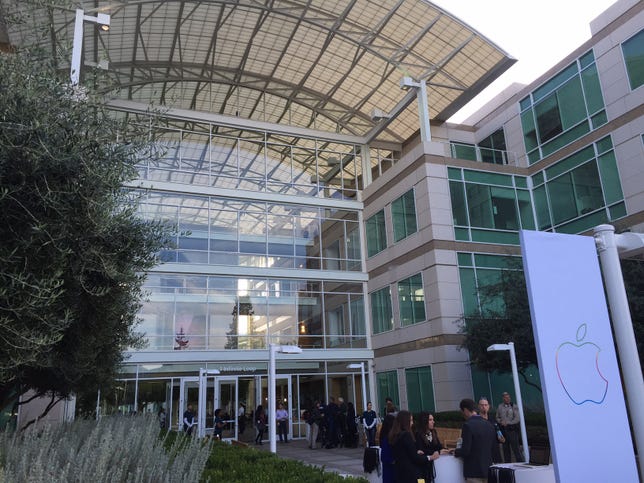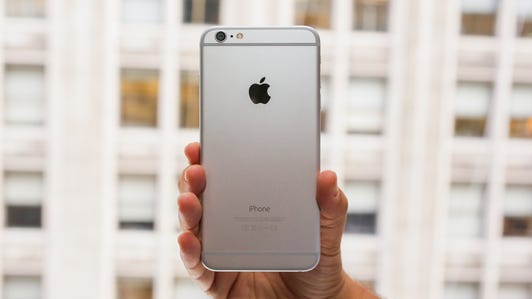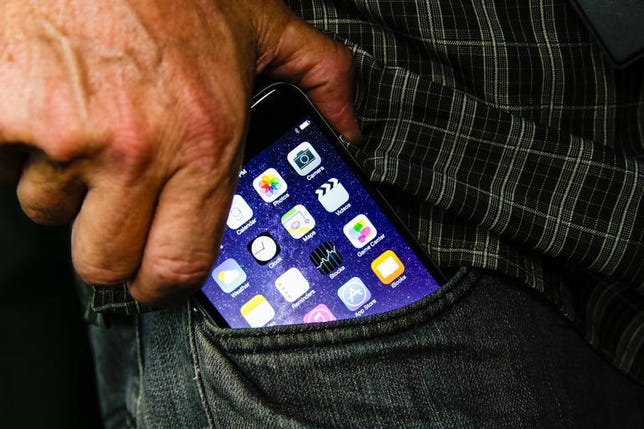
Shara Tibken/CNET
Here’s another feature found in the iPhone 6: The ability to propel Apple to another blowout quarter.
The Cupertino, Calif., electronics giant on Monday reported fiscal fourth-quarter revenue and earnings that topped Wall Street expectations. It also projected stronger sales for the current period than analysts anticipated and sold more iPhones than anticipated. The only negative remained iPad sales, which dropped for the third consecutive quarter and fell below Mac revenue for the first time in years.
“Our fiscal 2014 was one for the record books, including the biggest iPhone launch ever with iPhone 6 and iPhone 6 Plus,” Apple CEO Tim Cook said in a press release. “We are heading into the holidays with Apple’s strongest product lineup ever. We are also incredibly excited about Apple Watch and other great products and services in the pipeline for 2015.”
For the fiscal first quarter, which ends in December, Apple forecast revenue of $63.5 billion to $66.5 billion, better than the $63.52 billion projected by analysts, according to Thomson Reuters.
Shares closed Monday up 2 percent to $99.76 and rose another percent to $100.80 in after-hours trading. Apple in June split its stock 7-for-1 to make its shares more accessible to a larger number of investors. The move caused the company to adjust its previous financial results for comparison.
The iPhone 6 Plus is a gorgeous, massive smartphone (pictures)






Apple sold 39.3 million iPhones in the most recent period, up 16 percent from the year-ago period. Analysts, on average, had expected Apple to sell 37.8 million iPhones, according to a poll by Fortune. The company’s newest devices — the 4.7-inch iPhone 6 and the 5.5-inch iPhone 6 Plus — went on sale September 19, so Apple will get a bigger boost from the products in the December quarter.
“Demand for the new iPhones has been staggering,” Cook said during a conference call with analysts.
The company also sold 12.3 million iPads, down 13 percent from a year earlier. Analysts, on average, had expected Apple to sell 13.1 million iPads, according to a poll by Fortune.
Its Mac unit continued to be resurgent, with Apple shipping 5.5 million units, up 21 percent from a year ago. Cook noted sales were an all-time quarterly high for Macs, and Apple achieved its highest quarterly market share since 1995.
The earnings report comes after a big two months for Apple. The company in September launched its bigger-screen iPhone 6 and 6 Plus smartphones and showed off its first wearable, the Apple Watch. Apple also unveiled new iPads — the iPad Air 2 and iPad Mini 3 — and refreshed Macs during a more low-key event last week and introduced its Apple Pay mobile payments system. The products are key for Apple’s continued growth in the mobile market.
See also
- Apple, needing a jolt with new iPads, plays it safe instead
- Apple sells 10M iPhone 6 and 6 Plus devices in first weekend
- Samsung’s not done: Tech giant looks to new phones, materials to rally
- CNET’s take on the iPhone 6
“More important than this earnings report is that we believe Apple is in the midst of another ‘super cycle’ with a new product category expected to launch in early 2015 with Apple Watch, combined with the company’s recent entry in the ‘phablet’ market with the iPhone 6 Plus and the launch of Apple Pay,” Cantor Fitzgerald analyst Brian White said.
Apple generates about two-thirds of its sales from the iPhone and iPad, but the markets for those gadgets are becoming saturated, with rivals including Amazon, Google, Microsoft and Samsung battling for customers and the billions they spend on mobile devices. Apple’s newest iPhones, however, have attracted a record number of buyers since their launch last month. The iPhone 6 has the potential to be the biggest product launch in Apple’s 38-year history.
Cook said iPhone 6 and 6 Plus demand and it could stay that way through the end of the calendar year.
“It’s unclear, looking at the data, when supply will catch up with demand,” Cook said on a conference call. “It’s clear, as of today … we’re not even close. We’re not even on the same planet.”
The iPad hasn’t done as well. Apple’s newest tablets hit the market later this week, but analysts say the incremental changes likely aren’t enough to attract buyers in droves. The iPad may be a significant revenue driver, but the device hasn’t been selling as well as it used to. Large-screen smartphones are eating away at the need for a tablet, and consumers hold on to their iPads longer than their smartphones. Apple now faces questions over whether the iPad’s declining shipments are a temporary hiccup or a troubling trend.
The fiscal fourth quarter marks the third consecutive period that iPad sales have dropped. It’s also the first time Mac sales have surpassed iPad sales in several quarters. The iPad, which hit the market in April 2010, first overtook the Mac in terms of revenue in the June 2011 quarter. In the following years, the iPad solidly remained the second-biggest moneymaker for Apple, behind the iPhone smartphone. However, iPad sales have slipped this year, with the Mac segment coming closer and closer to beating its revenue.
Cook, for one, called iPad weakness “a speed bump” and said what while some customers likely are opting for Macs or iPhones over the tablet, iPad has a “great future.” He also said it’s too early to tell how long consumers will hold onto their tablets before upgrading, though they aren’t buying new models as quickly as they upgrade their iPhones.
“There’s a popular view that the market is saturated, but we don’t see that,” Cook said. “Because we’ve only been in this market four years, we don’t really know what the upgrade cycle will be for people.”


Now playing:
Watch this:
Apple Pay demo on iPhone 6 and new iPad
1:06
Rather than the consumer, Apple will increasingly lean on emerging markets and its push with business users and in schools to boost iPad sales. Already, most of the Fortune 500 companies use Apple products, but there are still a lot of ways the company could generate more money from business users.
It reached a deal with IBM in July to work together on pushing Apple devices and iOS apps with business users. IBM’s cloud-computing services — such as device management, security and analytics — also will be optimized for iOS. Apple a year ago also made its iLife and iWork software free with new Mac and iOS purchases. And Microsoft in March finally made its widely used Office software work on iOS.
At the same time, Apple’s Mac business remains important to the company, particularly as Apple makes its various devices work better together. While Apple has spoken against hybrid devices that switch between computers and tablets, its new computer operating system, OS X Yosemite , includes features that allow users to “hand off” tasks. That includes letting users start a program — such as writing an email or composing a text — on an iPhone and then finish it on an iPad or Mac.
Research firm IDC earlier this month said the company moved into the No. 5 ranking for global PC sales in the calendar third quarter. For the past several years, Apple has controlled a much smaller chunk of the market, but its sleek designs, such as the MacBook Air, have attracted customers.
“On the Mac, it was just an absolutely blowout quarter, our best ever,” Cook said. “It’s absolutely stunning. The back-to-school season voted, and the Mac won and carried the day.”
Apple’s overall results stand in contrast to rival Samsung, which earlier this month warned its third-quarter operating profit would tumble 60 percent and it sales would drop 20 percent. The company blamed higher marketing costs and competition for its problems. But the anticipated fourth consecutive quarterly drop in operating profit underscores the continued pressures facing smartphone king Samsung, which has been hit hard by saturation in the high-end market and intensifying pressure on the low end.
Hands-on with the new Apple iPad Air 2 and iPad Mini 3 (pictures)






The South Korean tech conglomerate believes “new smartphone lineups featuring new materials and innovative designs, as well as a series of new mid- to low-end smartphones with strong competitive positioning on both hardware specifications and price,” can help boost its results. But for Samsung, things may get worse before they get better.
Along with boasting about new devices, Apple also has taken steps to return more cash to shareholders. The company in April said it planned to give investors six additional shares of stock for every Apple share they owned as of June 2. Because of the split, shares now trade at a much lower level than in the past, but it also makes the stock more accessible to investors. It’s much cheaper to own a chunk of Apple at about $100 versus $600. The split went into effect in June, with shares trading at about $93.
The stock split came as part of Apple’s effort to meet the demands of current shareholders, as well as attract a new group of investors. Under the leadership of Cook, Apple started returning some of its massive cash hoard to investors. Shareholders, such as activist Carl Icahn, asked for even more, and Apple earlier this year revealed a big increase to its dividend and share repurchase program, along with the stock split. The company at that time boosted the amount of cash that it’s returning to shareholders by about $30 billion to more than $130 billion.


James Martin/CNET
Still, Icahn earlier this month again called for Apple to buy back more of its own stock. He argued that the iPhone maker’s shares should be worth twice as much as their current trading level. “You have said before that the company likes to be ‘opportunistic’ when repurchasing shares and we appreciate that,” Icahn said. “With this letter we simply hope to express to you that now is a very opportunistic time to do so.”
Luca Maestri, Apple’s chief financial officer, on Monday said Apple remains committed to returning cash to investors, and it reviews its plans regularly. The company has gotten feedback from shareholders in the past and will continue to do so.
“We plan to report on our conclusions on a time frame similar to last year,” he said.
For the fiscal fourth quarter, Apple posted a profit of $8.47 billion, or $1.42 a share, up from $7.51 billion, or $1.18 a share in the year-earlier period.
Revenue for the period ended September 27 jumped 12 percent to $42.12 billion, a record for the fiscal fourth quarter. International sales accounted for 60 percent of the quarter’s revenue.
Analysts most recently projected earnings of $1.31 per share on revenue of $39.88 billion. Apple in July said it anticipated revenue of $37 billion to $40 billion, slightly less than the $40.44 billion projected by analysts at the time. It also anticipated a gross margin of 37 percent to 38 percent.
Gross margin grew to 38 percent from 37 percent in the year-ago quarter. The company in July projected a gross margin of 37 percent to 38 percent. Apple’s gross margin, a measure of sales after removing costs like manufacturing, has fallen since its high of 47.4 percent in early 2012 as customers opt for lower-cost devices.
Updated at 2:10 and 3:20 p.m. PT with details from conference call.



